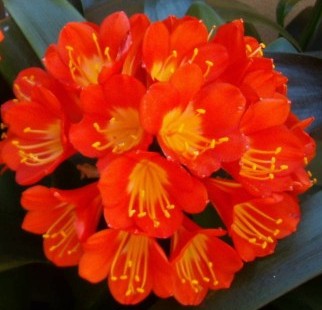 Also known as Natal lily, fire lily, and bush lily, Clivia is a clump forming herbaceous perennial belonging to the Amaryllidaceae family. It is native to South Africa and Swaziland where it grows in the dappled shade of evergreen forests. Fleshy rhizomes produce shiny, dark green, strap-shaped leaves two to three feet long and up to three inches wide that are very attractive and add considerable texture to the garden. Flower heads are carried on thick stems and are umbels composed of fifteen to twenty yellow, orange, or red trumpet shaped flowers that are long lasting on the plant and good in the vase. Decorative red berries follow the flowers but should be removed before they form as their development will inhibit flowering the following year. Since clivia is hardy only to USDA zone 9-10, but likes dry air and low light levels, it is often grown as a houseplant prized for its flowers in winter and early spring. Flowering is best when the plant is pot bound but must be divided every three to four years in late winter or early spring. When dividing, take care to untangle the roots carefully as they resent being disturbed.
Also known as Natal lily, fire lily, and bush lily, Clivia is a clump forming herbaceous perennial belonging to the Amaryllidaceae family. It is native to South Africa and Swaziland where it grows in the dappled shade of evergreen forests. Fleshy rhizomes produce shiny, dark green, strap-shaped leaves two to three feet long and up to three inches wide that are very attractive and add considerable texture to the garden. Flower heads are carried on thick stems and are umbels composed of fifteen to twenty yellow, orange, or red trumpet shaped flowers that are long lasting on the plant and good in the vase. Decorative red berries follow the flowers but should be removed before they form as their development will inhibit flowering the following year. Since clivia is hardy only to USDA zone 9-10, but likes dry air and low light levels, it is often grown as a houseplant prized for its flowers in winter and early spring. Flowering is best when the plant is pot bound but must be divided every three to four years in late winter or early spring. When dividing, take care to untangle the roots carefully as they resent being disturbed.
Type: Herbaceous perennial
Bloom: Umbels of yellow, orange, or red trumpet shaped flowers in winter and spring
Size: 18” h x 12” W
Light: Dappled shade
Soil: Fertile, moderately moist, well-drained when in growth; keep on the dry side in the fall when the plant is resting until the flowering stalk is six inches long. Too much water may result in root rot, yellow spots on the leaves, or failure to form a flowering stalk.
Hardiness: Zones 9-10; often grown as houseplant
Care: Fertilize when the flower buds appear; cut off spent flowers
Pests and Diseases: Scale, miles, black and white amaryllis caterpillar, aphids, white flies, thrips, mealy bugs, slugs, snails
Propagation: Division any time of year, offsets, seed (very slow)
Companion Plants: Camellia japonica, Abutilon, Tropaeolum (nasturtium), Justicia rizzinii (golden shrimp), Scadoxus puniceus (South African paintbrush lily), Hyacinthoides non-scripta (blubells), Brunfelsia species, Streptocarpus saxorum (nodding violet), Cryptanthus (earth star), Dieffenbachia species (dumb canes) Schefflera elegaantissima (false aralia), Ficus benjamina (weeping figs), Peperomia obtusifolia (blunt-leaf peperomias).